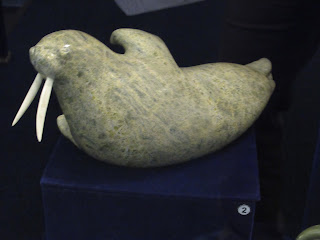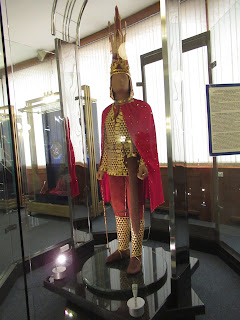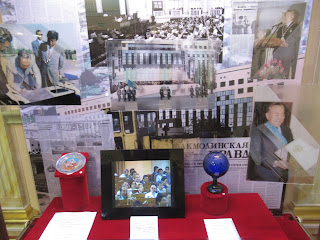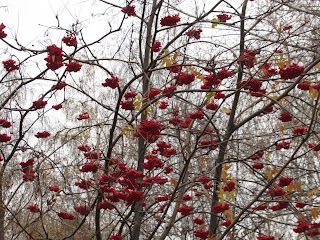Though still cloudy, we still had a much better view of the mountains that ring Almaty the morning we flew onto Astana, the capital of Kazakhstan, than we had the previous day.
Astana was just a medium-sized provincial city known for its bitter winters when President Nazarbayev named it out of the blue as Kazakhstan's future capital. It took over formally in 1997 from Almaty where we'd just spent the last several days. The city was formerly known as Akmola - Kazakh for White Tomb - and Tselinograd - Virgin Lands City - but was given the unimaginative name of Astana or 'capital' in Kazakh in 1998. Nazarbayev indicated the reasons for the change were better transport links with Russia, and a more central and less earthquake prone location. People think he may also may have wanted to try and head off secessionist sentiments among northern Kazakhstan's large ethnic Russian population.
The city is divided into two distinct areas, divided by the Ishim River. The old center, on the right bank, is the commercial and services center and was where our hotel was. South of the city on the left bank is where governmental and business buildings, and cultural, sports, leisure and shopping centers as well as eye-catching residential developments are going up. Some have dubbed Astana as 'Dubai of the steppe.' I think you'll agree that's an accurate description when you read the next post but I am getting ahead of myself!
The embroidered silk panel called Birds on a Pine Branch was a gift from North Korea. The birds can be seen in greater detail in the second photo.
My Canadian readers will know right away that the natural stone carving of a walrus could only be from our homeland!
The sublime Pelicans was a gift the president received when he visited China in 2004.
Steven pointed out the silver case for storing letters from Oman was just like the one we bought when we were in Nizwa, Oman, a few years ago.
What the museum referred to as a metal casting of a 'lamp' from Shimon Peres, Israel's President, in 2009 was of course a menorah!
In the dining or conference room were displays extolling the president's decision to move the capital to Astana and stating that it was one of the biggest projects in the former Soviet Union at the end of the 20th century and beginning of the 21st century.
Yet another representation of the Golden Man!
I thought of you, Zachary, when we saw the military helicopter at the civilian airport.
Steven was happy that our airline snack consisted of Choco Pies as he'd been snacking on the delicious chocolate marshmallow confection in several cities in Uzbekistan!
After getting a taxi ride to our hotel in Astana, we dumped our bags and began walking toward the only sight that made sense for the time we had left that day, the First President's Museum.
The city is divided into two distinct areas, divided by the Ishim River. The old center, on the right bank, is the commercial and services center and was where our hotel was. South of the city on the left bank is where governmental and business buildings, and cultural, sports, leisure and shopping centers as well as eye-catching residential developments are going up. Some have dubbed Astana as 'Dubai of the steppe.' I think you'll agree that's an accurate description when you read the next post but I am getting ahead of myself!
Even though we were in the older, commercial area, I still thought the new buildings with their wavy lines were very appealing and a far cry from anything we'd seen in a couple of months of traveling.
I had first noticed the same type of 'astroturf' figures in Turkistan, a town we had visited several days previously also in Kazakhstan.
Astana City Hall:
No idea which building this was but it looked fascinating.
At last we found the Museum of the First President of the Republic of Kazakhstan. Phew, what a long official name! Now if we could only find its entrance, we'd be all set. We finally realized, after walking around almost the entire building, the entrance was at the back.
Exhibits praising the president and his country:
After going through fairly rigorous security, we were at last inside. In the entrance hall was a map of Kazakhstan with a photo of President Nazarbayev. We laughed when museum staff gave us plastic booties to wear over our shoes to protect the carpets before touring the museum, especially since no staff wore them!
Steven joked he hated it when there were so many tourists in the museum's Dome Hall! In the hall's foyer was a collection of gifts presented to the President. The presented diplomatic gifts were grouped according to their material: stone, glass, wood, silver, etc.
The embroidered silk panel called Birds on a Pine Branch was a gift from North Korea. The birds can be seen in greater detail in the second photo.
The gift from Vietnam was a silk thread needlework piece called Lake of the Returned Sword in the Center of Hanoi. I took the photo as we'd been to that lake.
The Royal Dutch Shell Company presented its Fossilized Scallops gift in 2005. The bivalves from the Miocene period about 12 million years old, were found on the stone working mine in the south of France and were recovered from a single layer of quarry which had been completely filled with shells.
The sublime Pelicans was a gift the president received when he visited China in 2004.
The magnificent bone carving from the Chinese oil company, CITC, was a gift in 2007.
The fabulously intricate bone carving of a casket was a gift from India's ambassador in 2014. As gorgeous as the gift was, I was perplexed the ambassador would choose to give a casket.
As I wrote in a previous Almaty post, we saw several copies of the Golden Man, the 5th century BC Saka chief, that was discovered in the Almaty region in 1969-70. The supposedly accurate reconstruction of the chief's clothes was made based on system of arrangements of plates, plaques and other decorations that had been fixed at the time of the excavation. In the burial ground were over 4,000 items including a bronze mirror near the warrior, various wood, metal and gemstone vessels, a silver spoon, and a silver bowl with a runic or old alphabet inscription.
One anthropologist determined that the man buried in that spot had an European appearance typical for Semirechensk Saks with some Mongloid features and that he was from 16-18 years old and was a little over five feet tall. The reconstruction was made of metal, leather, fabric and galvanoplastics.
The Glass Blown Birds were a gift from Henry Kissinger, the former Secretary of State, when he visited Kazakhstan in 2005.
These schoolgirls were visiting Astana and were charged with doing a video recording of tourists about their impressions on the museum. How lucky they found me as Steven and I were the only tourists in the entire museum!
There were oodles of other exquisite gifts but the only Western country I saw represented was Canada. Otherwise, the gifts were from countries and companies in the Middle East, Asia, and Eastern Europe.
On another level was a model of the main building of the 'Library of the First President of the Republic of Kazakhstan.'
In the dining or conference room were displays extolling the president's decision to move the capital to Astana and stating that it was one of the biggest projects in the former Soviet Union at the end of the 20th century and beginning of the 21st century.
I found it frustrating that there were no information concerning dates or names on the photos to provide a frame of reference. They may well have been recognizable to Kazakhs but certainly not to tourists coming from outside the country.
I had known before coming to the museum that there had been a couple of changes in the country's capital but learned that in fact it changed several times during the country's history. During its nomadic period, the capital was set according to the location of a khan's residence which could move according to the season. That meant Suzak, Sygnak, Turkistan, Tashkent (now the capital of Uzbekistan), Semipalatinsk, Orenburg, Kyzl-Orda and Almaty were all Kazakhstan's capitals! Imagine being a Kazakh schoolchild and having to learn all your country's capitals!
A wool weaving of the Baiterek Tower, one of the new capital's marquee buildings that we'd be seeing in a couple of days.
More photos but again, no biographical information of how Nazarbayev rose from being a peasant to becoming the new nation's first president. I found it frustrating as I would have liked to have understood how that happened and therefore learned more, too, about the country.
Apparently the president worked from this office until 2004 until he moved elsewhere.
When this building was the president's residence from 1997-2004, the Meeting Hall was used to greet heads of state and members of the president's administration and mayors. The country's flag and oath of office were among the few exhibits.
The Temporary Exhibition Hall showed children's art works 'organized in the limits of the Republican program for support of the children's creativity.' Okay ...
The goal of the exhibition space called At the Dawn of Independence was to 'acquaint (visitors) with the history of gaining sovereignty by Kazakhstan and the first fatal independent steps which became a core of successful, stable formation of the statehood.'
That sounded like an interesting goal but none of the information was in English as to how the former Soviet republic achieved independence. There were only a smattering of photos, a few videos and some documents but none of it helped the foreign tourists learn what took place, how, when and why.
I think we were supposed to gather from the oil painting that something important in the country's history transpired at Ordabasy in 1997 but the museum provided no information as to what it was.
The timeline indicated the Alash Party happened in 1917, the institution of the presidency was established in 1990, the first national presidential election took place in 1991 and the closure of the Semipalatink test site was also in 1991. But little of that made any sense to us outsiders as we didn't know about the party, the test site, etc.
It was interesting seeing the regions of Kazakhstan divided up by the use of natural stones.
As a reviewer on Trip Advisor noted, 'it takes a lot of ego to set up a museum dedicated to yourself, but it is also this ego that must undeniably have made Kazakhstan what it is today.' It felt quite bizarre to me that a living and ruling president would open a four-floor museum dedicated entirely to himself although one floor was for the gifts he received from foreign leaders and companies. It was that display of gifts I enjoyed the most because it was in English! I really think the museum staff totally missed a great opportunity to not have the educational displays also in English.
There were more displays out front, or was it out back?! Again though, none were in English so we didn't more than glance at them.
I couldn't understand what a bench done up like one of Van Gogh's paintings was doing in the courtyard but was happy to sit on it for a minute!
The monument was to the founders of the Kazakh khanate, Kerey and Zhanibek.
As we walked back to the hotel, we made a point of stopping at the Monument to the Holodomor Victims of 1932-1933. For those unfamiliar with Holodomor, it was a manmade famine that took place under Stalin's direction in the Soviet Ukraine that killed millions of people.
Next post: Discovering new Astana including the Peace & Reconciliation Pyramid and the Palace of Independence.
Posted on November 17th, 2018, from Madrid, Spain.





























































I, too, agree that it is a waste of money to create such an ornate edifice to oneself. And why do other countries give such lavish gifts. Lil Red
ReplyDeleteGiving lavish gifts seems to be par for the course when meeting with foreign leaders from my albeit limited knowledge so i don't take umbrage with that, unlike the principle for the museum itself.
ReplyDelete